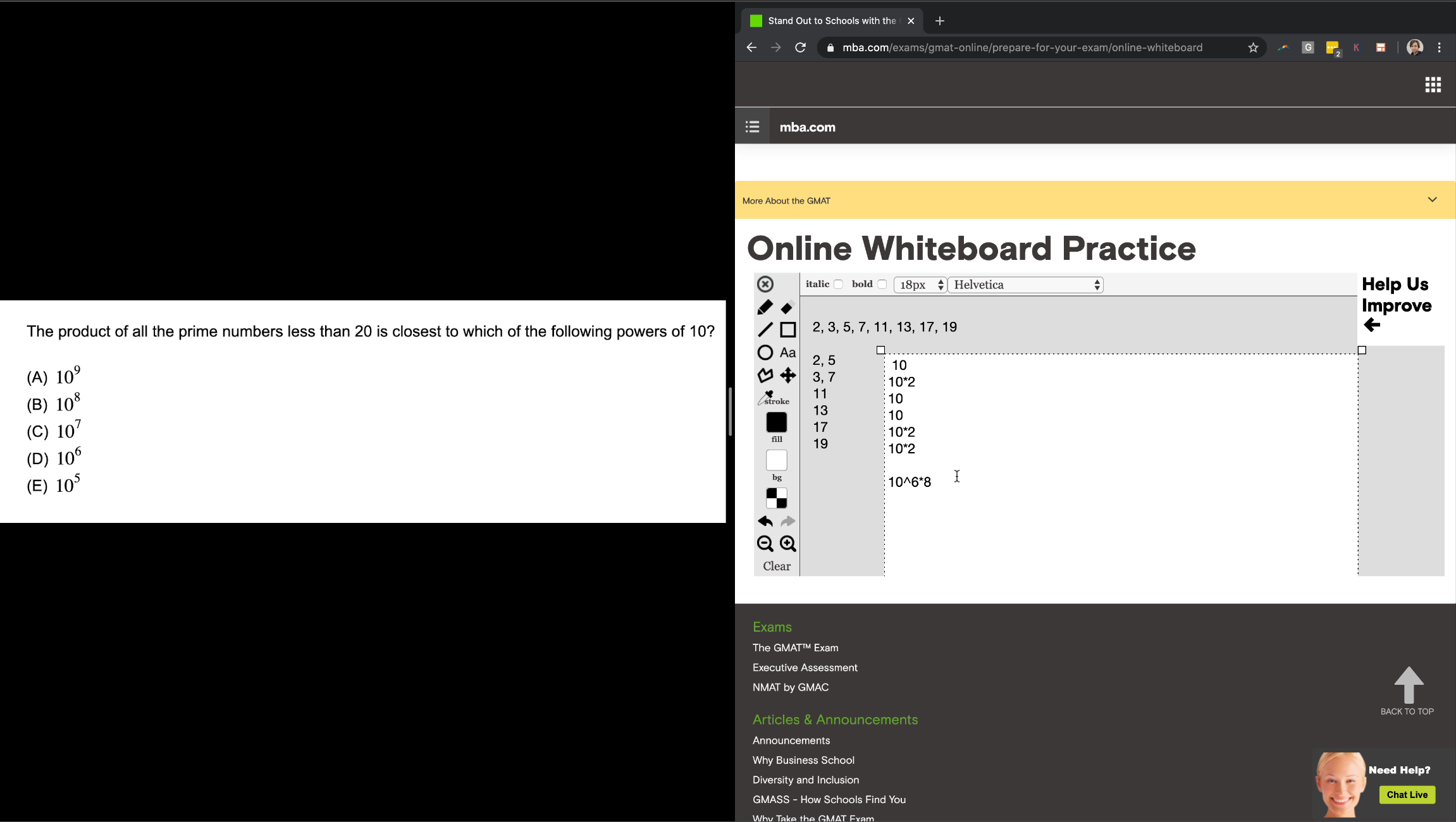The product of all the prime numbers less than 20 is closest to which of the following powers of 10? GMAT Explanation, Video Solution, and More Practice!
The product of all the prime numbers less than 20 is closest to which of the following powers of 10?
(A) 10^9
(B) 10^8
(C) 10^7
(D) 10^6
(E) 10^5
I really like this question. The type of thinking required for success here is exactly what you need to succeed overall on the GMAT and what we try to reinforce each and every tutoring session.
Prime numbers less than 20
Let’s list out those numbers. Take your time. Double check. This isn’t a race. Or at least it isn’t a sprint. You’ll end up saving time by doing work in a careful and considered way.
2, 3, 5, 7, 11, 13, 17, 19
Just a quick note on primes. 2 is the only even prime and the smallest prime. Important thing to have memorize for the GMAT.
Ok, so we’re looking to match a power of 10 with the product of these numbers. A power of 10 is 10*10*10… some number of times. So let’s figure out a way to translate the product of the those primes to powers of 10. Start easy. You don’t have to figure out everything all at once.
2*5 = 10. Great, we’ve got one 10.
3*7 = 21 which is basically 2*10
11 is basically 10
13 is a bit of a stretch but let’s call it 10 for now and judge whether it’s OK once we’ve got the first round done.
17 let’s call 20 and maybe it balances out 13.
19 let’s call 20 and it balances out 11.
So we’ve got 10*10*10*10*10*10*2*2*2*2. So 10^6*8. That’s closest to 10^7.
Now, I get that you might be skeptical of the approximation BUT we did a reasonable approximation and 10^6*8 is way closer to 10^7 than 10^6. It’s not close. In GMAT land I think that’s good enough and I’d pick C and move on.
There is an underlying principle that proves this without a doubt that’s worth knowing.
Consider:
2*100 = 200
2*101 = 202
3*100 = 300
When we added 1 to 100 we moved from 200 to 202.
When we added 1 to 2 we moved from 200 to 300.
So adding a fixed value to smaller number creates a bigger change. That makes sense since the fixed value increases the smaller by a greater percent than it increases the bigger number.
Back to our question!
2*5 = 10
3*7
11 (-1) vs 19 (+1) Given the above idea which move has more influence? The smaller one, 11.
13 (-3) vs 17 (+3) Same thing here. 13 has more influence.
So with those two we 100% underestimated. And then with 7*3 we also went down to 20. So it’s clear that our approximation was even smaller than the actual number guaranteeing that the product of all the primes less than 20 is closest to 10^7.
Correct Answer: C

Just a quick note beyond this question. So we showed above that when adding a fixed value to a number the magnitude of the number you’re adding to changes the affect of the number you add (adding a fixed value to 2 will have more impact on 2 than on a larger number say 100000).
Multiplication is different. Multiplying something by 2 doubles it’s value regardless of the original magnitude (2*2 is 4, 2*100 is 200). Of course you know that. But it’s important on the GMAT to put this all together in a meaningful way. We call it “absolute vs relative” and it comes up a decent amount especially on the GMAT Data Sufficiency. It tends to be that relative info (multiplication) which stays constant regardless of the magnitude of the underlying numbers is usually more helpful than absolute info, addition/subtraction.
Video Solution: The product of all the prime numbers less than 20 is closest to which of the following powers of 10?
Additional GMAT Puzzle Question Practice
Not the same but requires similar GMAT-puzzle-thinking. Here’s a GMAT Question of the Day puzzle dealing with exponents and primes
Another similar but different puzzle question. This GMAT Question of the Day Exponents Puzzle deals more with constraints but again still tests the same type of organization skills that lead to success in the above primes question.
